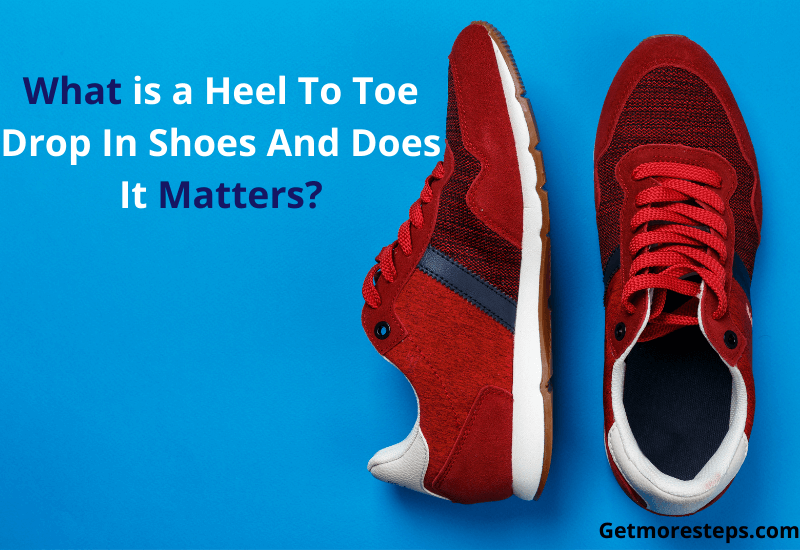When buying a pair of walking shoes, you’ll often see people asking for the heel drop because this feature plays a significant role in making the foot comfortable. If you are familiar with this term, then good for you, but if you are not, it can be frustrating, especially when it comes to your feet’ comfort. So if you want to know what is a heel to toe drop in shoes, continue reading.
What is a Heel To Toe Drop?
Contents
- 1 What is a Heel To Toe Drop?
- 2 The Difference Between Heel Stack and Heel Drop.
- 3 What Difference Does Heel Drop Make?
- 4 What Are the Ranges Of Heel Drop?
- 5 0mm – Zero Drop
- 6
- 7 4-7 mm – Low Drop
- 8 Is a Heel Drop Really Matters?
- 9 Things to Consider When Selecting Shoes By Drop
- 10 What Heel Drop is Best?
- 11 My Final Words
Heel-to-toe Drop means that the heel is higher than the ball of the foot. In other words, there is a difference in height between the heel and the forefoot. For instance, in a 12mm drop, your heel will sit 12mm higher than the shoes’ front part.
Shoe companies use other terms to refer to the heel to toe drop, such as:
- shoe drop
- heel drop
- offset
- pitch
- Heel differential
- Gradient
The heel drop is evaluated in millimeters. It’s measured by subtracting the heel height stack and forefront height stack.
As an example: Heel height 40mm – Forefoot height 30mm = 10mm heel to toe drop.
The Difference Between Heel Stack and Heel Drop.
A heel drop is different from stack height. A stack height refers to the thickness of the midsole. To be more precise, it’s the amount of material between the footbed and the outsole. Some shoes have a heel drop of 12mm with 18mm stack height. On the other hand, there are zero heel drop shoes with 35mm stack height. So don’t confuse between heel drop and stack height as they are entirely different.
What Difference Does Heel Drop Make?
Every heel drop will affect a different area of the joints. According to podiatrists, a high heel drop takes off the pressure of the lower leg (foot, ankle, Achilles, calf); by contrast, it puts more stress on the knees and hips. However, A low drop will be easier on the knees but will put more pressure on the lower leg.
What Are the Ranges Of Heel Drop?
Heel drop range from 0mm, which can be found in many walking shoes, to 14mm in running shoes. When buying a pair of walking shoes and choosing a heel to toe drop, these are the things to take into account:
0mm – Zero Drop
Design
Shoes with a zero heel drop, which are usually called barefoot, have no drop. Meaning, your heel will be at the same level as your forefoot in the footwear. They have a flat sole, a spacious toe box but don’t have any arch support, almost no cushioning, and neither stability nor motion control features to correct the gait. Note that there are some zero drop shoes with high stack height, as I mentioned before, which provide more cushioning. However, barefoot are lightweight and flexible, which improve cadence during the walks or runs.
Heel Drop effect
Zero drop shoes promote the midfoot or forefoot strike and allow your feet to sit in a natural position, helping align your posture and spine. It also provides better flexion of the ankle when you walk or run. Zero Drop minimizes the impact on the knees but places more stress on the ankle, foot, (lower leg). It also helps with gluteus medius syndrome and ITB knee pain.
4-7 mm – Low Drop
Design
This heel drop is for people who prefer to feel the ground under their feet but don’t want to wear a zero drop (barefoot). These shoes are called minimalists. These have a little more cushioning and offer more impact protection than barefoot shoes. They are flexible, lightweight with very little arch support. Like barefoot shoes, minimalist footwear maintains a more natural walking gait and keeps your joints aligned.
Heel Drop Effect
As it’s also considered a low heel drop, it does about the same as barefoot shoes. Meaning, reduce the pressure of the knee but place greater force on the lower leg.
8-14mm – High Drop
Design
This is one of the most common heel drops in walking or running shoes as it suits a wide variety of people’s gait. These are more cushioned in the heel, thus providing more protection during landing. Since 10mm drop shoes are very demanded, you’ll find a wide selection of models ranging from walking, hiking, trail, stability to running shoes.
Heel Drop Effect
8-14 mm are considered high Drop, this will affect different parts of the body. A high drop protects the heel from shock since there is more padding in the heel. A high heel drop puts more stress on the knees and hips and will be easier on the lower leg ( Achilles, Calfs, ankle feet). These help with calf injuries, Achilles tendinopathy, and plantar fasciitis.
Is a Heel Drop Really Matters?
It depends; some people will feel more comfortable walking or running in zero heel drop shoes, while others will prefer wearing 12mm heel drop. A heel drop can be an important element if you have or had joint injuries in the past, say podiatrists.
Athletes that strike aggressively on the heel would be better off with a high drop of 10-12mm since they need more protection. Runners that land on the mid and forefoot usually prefer wearing a lower drop. The same goes for walkers; a low drop would be ideal since they strike on the heel then roll through the step.
Those who have tight calves or Achilles tendonitis issues also may need to stay with a high drop to reduce pressure on the tendon. Something to keep in mind, a low drop increases calf flexibility and ankle mobility. A high drop will do the opposite.
Things to Consider When Selecting Shoes By Drop
- When choosing your walking shoes, focus on comfort, not the heel drop.
- If the heel drop is not indicated in the details, check the stack height in the shoes’ description and subtract the heel height stack from the forefoot height stack. You’ll obtain the exact heel drop number of the shoes.
- If you plan on changing heel drop, you must do it gradually, especially if you switch from a high to a low drop shoe. People often feel some soreness in the Achilles tendon or calf during the adaptation phase.
What Heel Drop is Best?
So far, no science has proven that one type of shoe is better than the other. You may find that a higher or a lower drop is best for you. So at the end of the day, choosing the right heel drop comes down to your personal preference. What matters most is that you feel comfortable in your shoes.
My Final Words
If you are comfortable walking or running with your current drop shoes, you might consider staying with the same drop. However, if you decide to change your shoes’ heel drop, make sure you do it gradually so your body can get used to it.
If you transition too quickly, you may get Achilles tendon, and calf muscle strains, which you want to avoid. If you go from a high drop to a low drop, I suggest you wear the shoe you have been walking in every other day for a few weeks.
On the other hand, if you go from a low drop to a high drop, the adaptation time will be faster because your muscles won’t need to work as hard as they would if you go from a low to a high drop.
What heel to toe drop shoes do you wear? What drop do you feel more comfortable with? I would love to know?
I hope you found this article useful, if you did, share it with your friends and family. Thanks!

I don’t know about you, but I love my feet because they allow me to walk and go wherever I want to go. Without them, I would be lost! So I always spoil them with a good pair of walking shoes to make sure they are as comfortable as possible. If you take care of your feet, they will take care of you and your health. Well, fitted shoes will protect them and allow you to get more steps without pain!
Read more about me
